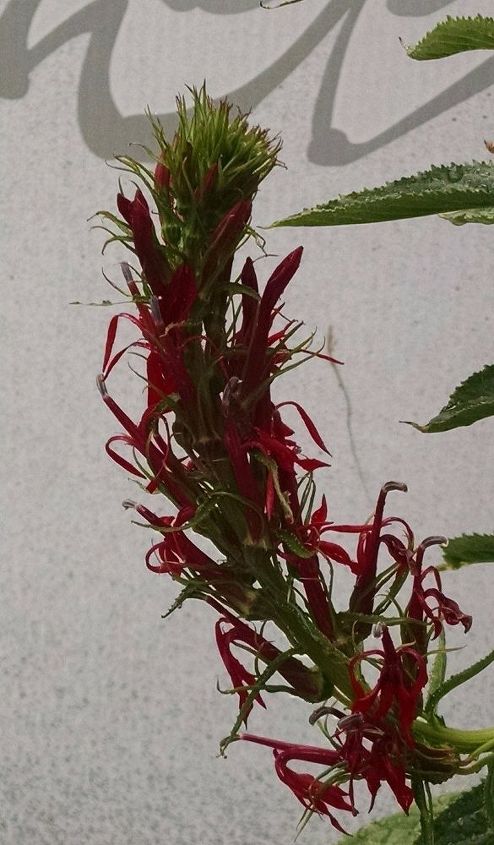What type of plant is this?

-
It looks like an Aloe.
 Rosemary Mason
on Jul 24, 2016
Helpful Reply
Rosemary Mason
on Jul 24, 2016
Helpful Reply -
-
I think it's in the Aloe family and I'm thinking it's some sort of succulent though. Kind of neat :)
 Janet
on Jul 24, 2016
Helpful Reply
Janet
on Jul 24, 2016
Helpful Reply -
-
If possible, show us the leaf and whole plant - not just the flower.
 Nancy Nesbitt
on Jul 24, 2016
Helpful Reply
Nancy Nesbitt
on Jul 24, 2016
Helpful Reply -
-
That would really help! How tall is it? From the flower, it could be cardinal flower, red penstemen.
 DORLIS
on Jul 24, 2016
Helpful Reply
DORLIS
on Jul 24, 2016
Helpful Reply -
-
Cardinal flower. Lobelia cardinalis. Moist soil, part shade. Perennial. Will reseed itself.
 Shirlee m
on Jul 24, 2016
Helpful Reply
Shirlee m
on Jul 24, 2016
Helpful Reply -
-
I agree with Shirlee m, looks like Lobelia to me.
 Lisa Falkenthal
on Jul 25, 2016
Helpful Reply
Lisa Falkenthal
on Jul 25, 2016
Helpful Reply -
-
The picture is not clear enough but from the little I can see the leaves appear to be from the Aloe Vera family.
 Bernadette Staal
on Jul 25, 2016
Helpful Reply
Bernadette Staal
on Jul 25, 2016
Helpful Reply -
-
yes Cardinal flower
 Judy
on Jul 26, 2016
Helpful Reply
Judy
on Jul 26, 2016
Helpful Reply -
-
Lobelia cardinalis....Cardinal flower. Prefers full sun, keep it moderately moist until well established.
 Connie Damstra Allbright
on Jul 26, 2016
Helpful Reply
Connie Damstra Allbright
on Jul 26, 2016
Helpful Reply -
-
I have several Cardinal Lobelia my does not look like that at the tip and they love the morning sun, it cold be a part of the lobelia family though.
 Mary
on Jul 28, 2016
Helpful Reply
Mary
on Jul 28, 2016
Helpful Reply -
-
I looked closer at the plant and it looks more like a Cardinal Plant! Amaranthus caudatus is a species of annual flowering plant. It goes by common names such as love-lies-bleeding,[2] pendant amaranth,[citation needed] tassel flower,[2] velvet flower,[2] foxtail amaranth,[2] and quilete.[citation needed] Many parts of the plants, including the leaves and seeds, are edible, and are frequently used as a source of food in India and South America – where it is the most important Andean species of Amaranthus, known as kiwicha. (see also Amaranth seed and Andean ancient plants) This species, as with many other of the amaranths, are originally from the American tropics. The exact origin is unknown, as A. caudatus is believed to be a wild Amaranthus hybridus aggregate. The red color of the inflorescences is due to a high content of betacyanins, as in the related species known as "Hopi red dye" amaranth. Ornamental garden varieties sold under the latter name are either Amaranthus cruentus or a hybrid between A. cruentus and A. powelli. In indigenous agriculture, A. cruentus is the Central American counterpart to South American A. caudates.
 Anganetta Dover
on Jul 29, 2016
Helpful Reply
Anganetta Dover
on Jul 29, 2016
Helpful Reply -
-
Look up the Lobelia, Great Blue the plant looks like that one although it is in the Lobelia family.
 Mary
on Jul 29, 2016
Helpful Reply
Mary
on Jul 29, 2016
Helpful Reply -
Related Discussions
GNATS - How to get rid of them?
Somehow my house and garden got tiny gnats that killed my fuchsia plant and fly everywhere. I have tried ALL the Web recommendations - soap and oil dishes, sand in th... See more
Marigolds growing! Should I pinch the buds?
My marigold plants are growing. I heard that pinching the buds until Autumn will allow them to grow without killing the plant. Is this true?
Growing garlic
Growing our first garlic, should we wait until the leaves are drying out before we pick it? Husband picked first one today along with our first potatoes.
How to keep mice out of your garden?
Hi everyone, I have mice in my garden destroying my vegetables and I have also noticed them in the barn and shed. Please can someone tell me how to prevent them from ... See more
What's the best flower/plant to grow in Texas?
I know that opinions vary, but what's your opinion?!I have great luck w Rosemary plants. Green all year long.
What type of plants can be used to plant in boulder wall crevices?
I forgot what I planted!
Can anyone identify these young veggie plants please? I get my seeds from food we buy from the shops, germinate them in tissue, and plant in our gardens. I have plant... See more




